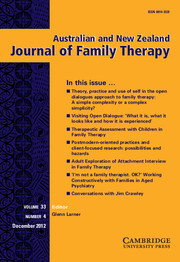Article contents
Nothing to Fear? Thoughts on the History of Family Therapy and the Potential Contribution of Research
Published online by Cambridge University Press: 03 August 2012
Abstract
The aim of this plenary address is to advocate for the role that research can play in family therapy, with particular reference to our future as a field in Australia. I will argue: 1) that we have been in transition as a field in the past 15 years or so, from a fairly closed system, to one that is more amenable to holding itself to account through research; 2) that we hold a number of misconceptions about research that need to be explored if we are to continue; 3) that we need to develop a research agenda that is consistent with our values and 4) that there are a host of research methodologies that are consistent with our epistemologies and modes of practice.
- Type
- Articles
- Information
- Australian and New Zealand Journal of Family Therapy , Volume 33 , Issue 2 , June 2012 , pp. 171 - 182
- Copyright
- Copyright © The Authors 2012
References
- 4
- Cited by




